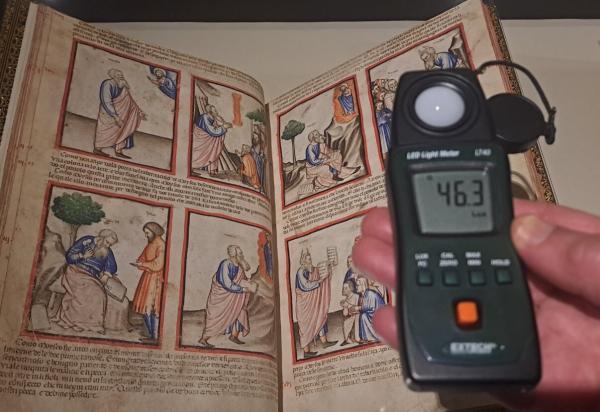Lux Light Level and UV Testing for Museums & Galleries
What is good lighting for museums galleries and exhibits?
One of the fundamental responsibilities of any museum, organisation, or collector is to measure and continually monitor the total amount of light that collections are exposed to.
The level and speed of any light damage will be determined by the kind and intensity of the light source and the length of time it is exposed. Of course, different artefacts will have higher resistance to light than others. This damage is visual fading and can cause discolouration, weaken, and make, for example, textiles and other organic materials brittle.
Therefore, at the very least, a lux-level spot test is essential. Or, better yet, one that includes UV levels. This should be implemented ASAP when environments such as galleries and museums are sensitive. This is because the damage caused by overexposure to light is irreversible. You may have already read our conservation lighting article, “It’s a one-way disappearing act!“? Consequently, you will understand the extraordinary balancing act of displaying light-sensitive art and historical artefacts.
We illuminate sensitive artefacts with minimum risk
Lux Light Level and UV Testing – ensuring beautifully lit and safe spaces
Surveys & Monitoring
When taking lux readings, you must ensure that if LED light sources are present, your first step is to have the appropriate light meter at hand. Some older light meters do not read LED lights correctly. Your light meter must be placed in the right plane and not blocked by your shadow.
Another consideration is how much natural light is coming into the space. This will change with the season, weather, and time of day. Moreover, this should be recorded throughout the year to monitor and accurately average the light levels and exposure hours. Some new smart lighting systems can do this automatically, such as closing blinds to adjust the amount of natural lighting coming into the space.
To determine how much light is from artificial light sources, you can either blackout environments from natural light or carry out testing at night. This ensures that most of the light you measure comes from an artificial light source. Of course, there will still be some light from the moon and external light sources.
Once you have conducted your lux level testing and documented the results, you need to start taking the necessary action to control the light levels to get them within expected levels.
Remember: Lux & UV Levels x Hours of Exposure = Lux and UV Cumulative Hours (Increased Potential Damage)
When placing light-sensitive objects in storage, it’s essential to ensure that the environment is dark to prevent any damage. Light can cause fading, discolouration, and other forms of deterioration, especially when objects are exposed for prolonged periods. To monitor the impact of light on objects, blue wool dosimeters (also known as blue-scale textile fading cards) can be used.
These cards are designed to mimic the light sensitivity of certain materials and serve as sacrificial materials that will fade over time at a known rate. By placing them in areas, such as showcases or storage rooms, you can track the amount of light exposure and determine if any adjustments need to be made to the environment. The blue wool dosimeters are inexpensive, easy to use, and provide a reliable method for monitoring light exposure to protect valuable objects.
By either covering half of the dosimeters with something opaque (so it is not exposed to light) or by having another as a comparison, it is possible to visually gauge the level of fading caused by the light levels present over a set period.
Most museums will generally aim for an average of 50-100 lux and a short exposure time for sensitive objects. Some artefacts, like papyrus, should be around 35 lux or as low as possible whilst still being able to view the item on display.
We have primarily focused on Lux levels in this article. Nevertheless, it is also necessary to measure UV levels. Ultraviolet radiation is measured in(µW/lm), which is a fraction of visible light. Nevertheless, this type of testing requires a much more expensive piece of equipment.
Our museum lighting designers can advise on both types of light testing. We undertake lighting surveys, monitoring and conservation measures to control the light. Next time, let’s look at how to utilise this information correctly and ways to reduce these harmful light levels.

